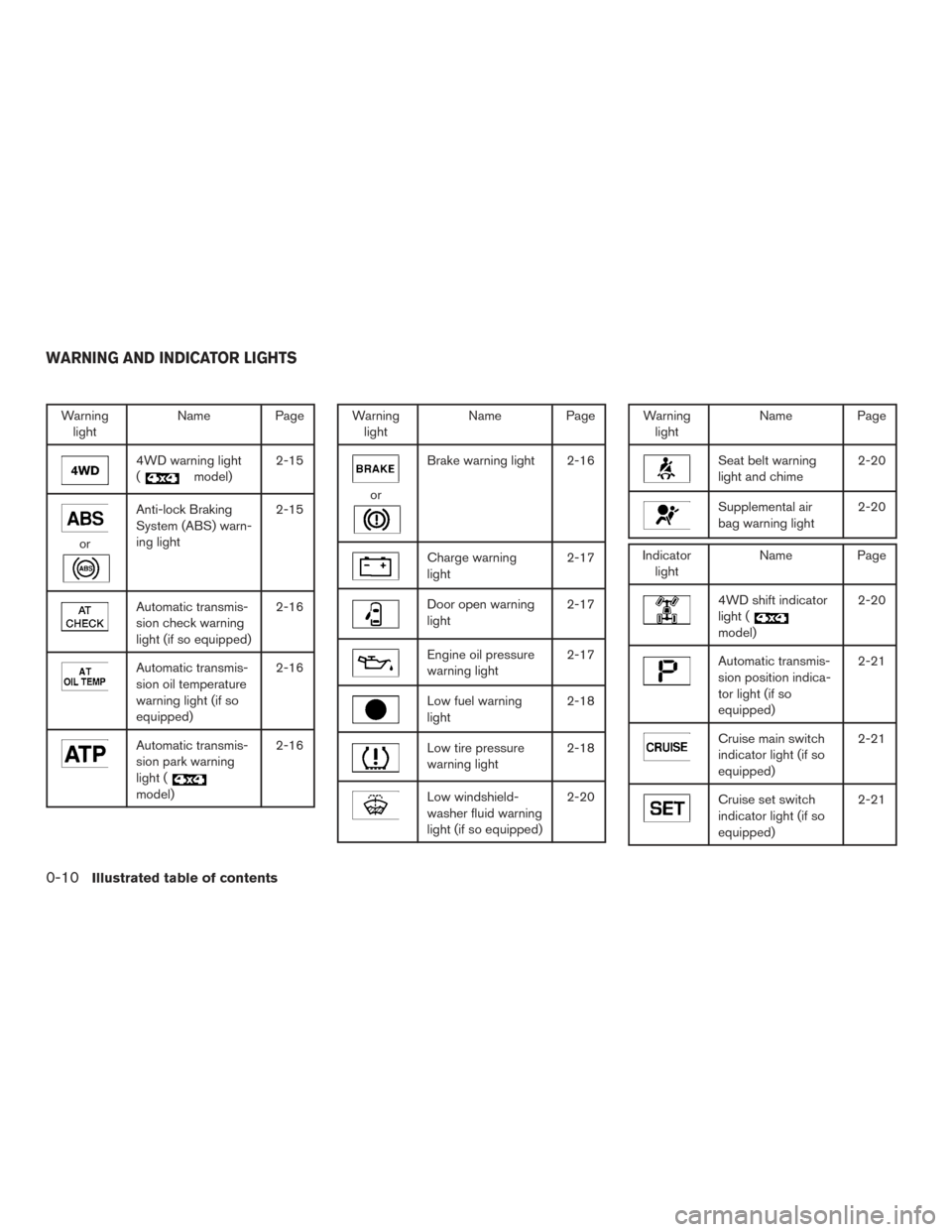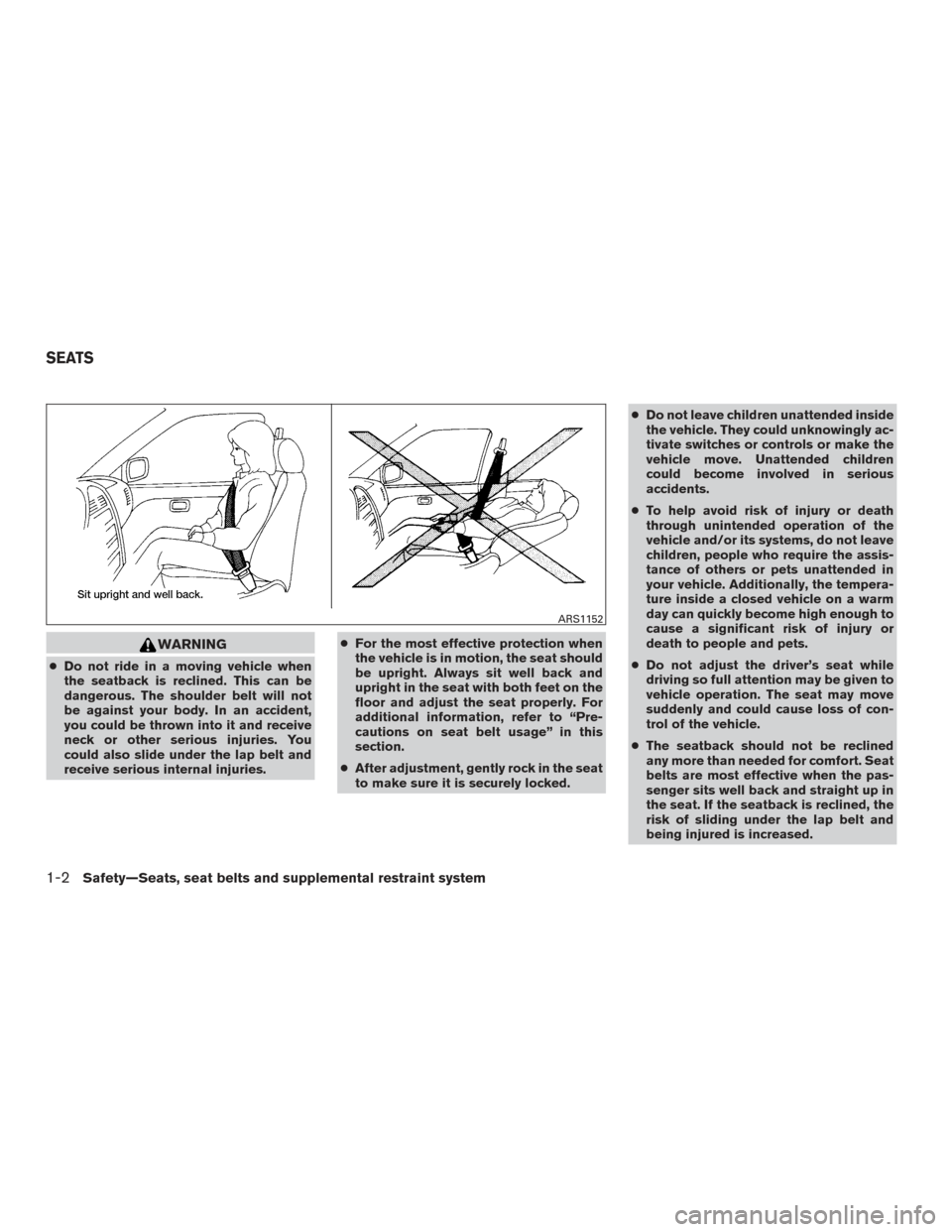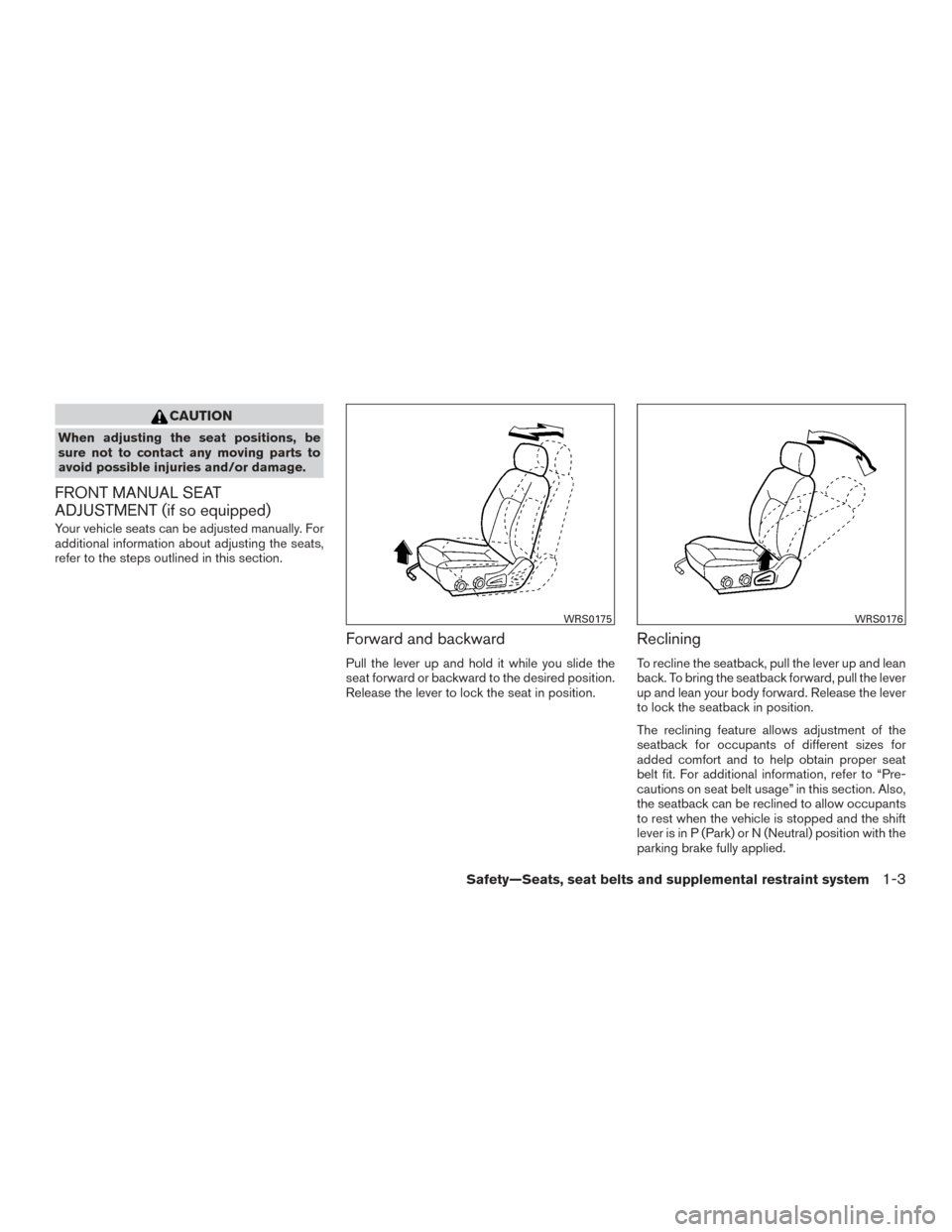Page 12 of 478
1. Engine hood (P. 3-10)
2. Wiper and washer switch (P. 2-27)
3. Windshield (P. 8-19)
4. Windows (P. 2-49)
5. Door locks (P. 3-3)Key fob (if so equipped) (P. 3-6)
Keys (P. 3-2)
6. Mirrors (P. 3-15)
7. Tire pressure (P. 8-30) Flat tire (P. 6-3)
Tire chains (P. 8-30)
8. Headlight and turn signal switch
(P. 2-29)
Daytime running lights system
(if so equipped) (P. 2-29)
Replacing bulbs (P. 8-26)
9. Fog light switch (if so equipped)
(P. 2-29)
Refer to the page number indicated in pa-
rentheses for operating details.
LII2481
EXTERIOR FRONT
Illustrated table of contents0-3
Page 16 of 478
15. Electronic locking rear differential(E-Lock) system switch (if so
equipped) (P. 2-37)
Heated seat switch (if so equipped)
(P. 2-34)
Rear sonar switch (if so equipped)
(P. 2-38)
Vehicle Dynamic Control (VDC) OFF
switch (P. 2-35)
16. Shift lever (P. 5-14)
17. 4WD shift switch (if so equipped)
(P. 5-25)
18. Climate controls (P. 4-17)
19. Hazard warning flasher switch (P. 6-2)
20. Ignition switch (P. 5-10)
21. Tilt steering wheel control
(if so equipped) (P. 3-13)
22. Cargo lamp switch (P. 2-34) Clutch interlock (clutch start) switch
(if so equipped) (P. 2-38)
Hill descent control switch
(if so equipped) (P. 2-36)
Outside mirror controls (if so equipped)
(P. 3-15)
Illustrated table of contents
0-7
Page 19 of 478

Warninglight Name Page
4WD warning light
(
model)2-15
or
Anti-lock Braking
System (ABS) warn-
ing light 2-15
Automatic transmis-
sion check warning
light (if so equipped)2-16
Automatic transmis-
sion oil temperature
warning light (if so
equipped)2-16
Automatic transmis-
sion park warning
light (
model)2-16
Warning
light Name Page
or
Brake warning light 2-16
Charge warning
light 2-17
Door open warning
light2-17
Engine oil pressure
warning light2-17
Low fuel warning
light2-18
Low tire pressure
warning light2-18
Low windshield-
washer fluid warning
light (if so equipped)2-20
Warning
light Name Page
Seat belt warning
light and chime 2-20
Supplemental air
bag warning light2-20
Indicator
light Name Page
4WD shift indicator
light (
model) 2-20
Automatic transmis-
sion position indica-
tor light (if so
equipped)2-21
Cruise main switch
indicator light (if so
equipped)
2-21
Cruise set switch
indicator light (if so
equipped)2-21
WARNING AND INDICATOR LIGHTS
0-10Illustrated table of contents
Page 20 of 478
Indicatorlight Name Page
Electronic locking
rear differential (E-
Lock) system ON
indicator light (if so
equipped) 2-21
Front passenger air
bag status light
2-21
High beam indicator
light (blue)2-21
Hill descent control
system ON indicator
light (if so equipped)2-21
Malfunction Indica-
tor Light (MIL)
2-22
Overdrive OFF indi-
cator light (if so
equipped)2-22
Security indicator
light (if so equipped)
2-22
Indicator
light Name Page
Slip indicator light 2-23
Transfer 4LO posi-
tion indicator light
(
model)2-23
Turn signal/hazard
indicator lights
2-23
Vehicle Dynamic
Control (VDC) OFF
indicator light2-23
Illustrated table of contents0-11
Page 23 of 478

WARNING
●Do not ride in a moving vehicle when
the seatback is reclined. This can be
dangerous. The shoulder belt will not
be against your body. In an accident,
you could be thrown into it and receive
neck or other serious injuries. You
could also slide under the lap belt and
receive serious internal injuries. ●
For the most effective protection when
the vehicle is in motion, the seat should
be upright. Always sit well back and
upright in the seat with both feet on the
floor and adjust the seat properly. For
additional information, refer to “Pre-
cautions on seat belt usage” in this
section.
● After adjustment, gently rock in the seat
to make sure it is securely locked. ●
Do not leave children unattended inside
the vehicle. They could unknowingly ac-
tivate switches or controls or make the
vehicle move. Unattended children
could become involved in serious
accidents.
● To help avoid risk of injury or death
through unintended operation of the
vehicle and/or its systems, do not leave
children, people who require the assis-
tance of others or pets unattended in
your vehicle. Additionally, the tempera-
ture inside a closed vehicle on a warm
day can quickly become high enough to
cause a significant risk of injury or
death to people and pets.
● Do not adjust the driver’s seat while
driving so full attention may be given to
vehicle operation. The seat may move
suddenly and could cause loss of con-
trol of the vehicle.
● The seatback should not be reclined
any more than needed for comfort. Seat
belts are most effective when the pas-
senger sits well back and straight up in
the seat. If the seatback is reclined, the
risk of sliding under the lap belt and
being injured is increased.
ARS1152
SEATS
1-2Safety—Seats, seat belts and supplemental restraint system
Page 24 of 478

CAUTION
When adjusting the seat positions, be
sure not to contact any moving parts to
avoid possible injuries and/or damage.
FRONT MANUAL SEAT
ADJUSTMENT (if so equipped)
Your vehicle seats can be adjusted manually. For
additional information about adjusting the seats,
refer to the steps outlined in this section.
Forward and backward
Pull the lever up and hold it while you slide the
seat forward or backward to the desired position.
Release the lever to lock the seat in position.
Reclining
To recline the seatback, pull the lever up and lean
back. To bring the seatback forward, pull the lever
up and lean your body forward. Release the lever
to lock the seatback in position.
The reclining feature allows adjustment of the
seatback for occupants of different sizes for
added comfort and to help obtain proper seat
belt fit. For additional information, refer to “Pre-
cautions on seat belt usage” in this section. Also,
the seatback can be reclined to allow occupants
to rest when the vehicle is stopped and the shift
lever is in P (Park) or N (Neutral) position with the
parking brake fully applied.
WRS0175WRS0176
Safety—Seats, seat belts and supplemental restraint system1-3
Page 29 of 478
●When returning the seatbacks to the
upright position, be certain they are
completely secured in the latched posi-
tion. If they are not completely secured,
passengers may be injured in an acci-
dent or sudden stop.
● Properly secure all cargo to help pre-
vent it from sliding or shifting. Do not
place cargo higher than the seatbacks.
In a sudden stop or collision, unsecured
cargo could cause personal injury.
Folding the rear bench seat up (if so
equipped)
To fold the rear bench seat up:
1. Lift up on the lever, located on the side of the seat, while lifting the front of the seat cush-
ion up. 2. Fold the bottom of the seat cushion toward
the back of the vehicle until it locks in place.
LRS2475LRS2476
1-8Safety—Seats, seat belts and supplemental restraint system
Page 32 of 478
●Adjustable head restraints/headrests have
multiple notches along the stalk(s) to lock
them in a desired adjustment position.
● The non-adjustable head
restraints/headrests have a single locking
notch to secure them to the seat frame.
● Proper Adjustment:
– For the adjustable type, align the head restraint/headrest so the center of your
ear is approximately level with the center
of the head restraint/headrest. – If your ear position is still higher than the
recommended alignment, place the head
restraint/headrest at the highest position.
● If the head restraint/headrest has been re-
moved, ensure that it is reinstalled and
locked in place before riding in that desig-
nated seating position.ADJUSTABLE HEAD RESTRAINT/
HEADREST COMPONENTS
1. Removable head restraint/headrest
2. Multiple notches
3. Lock knob
4. Stalks
King Cab
LRS2362LRS2300
Safety—Seats, seat belts and supplemental restraint system1-11